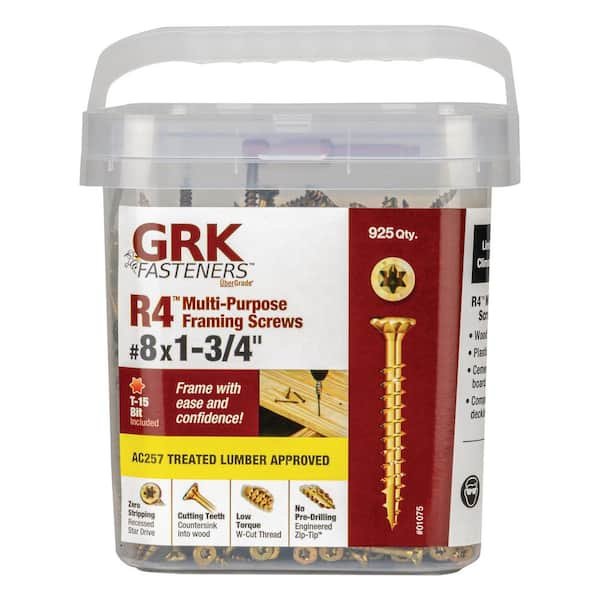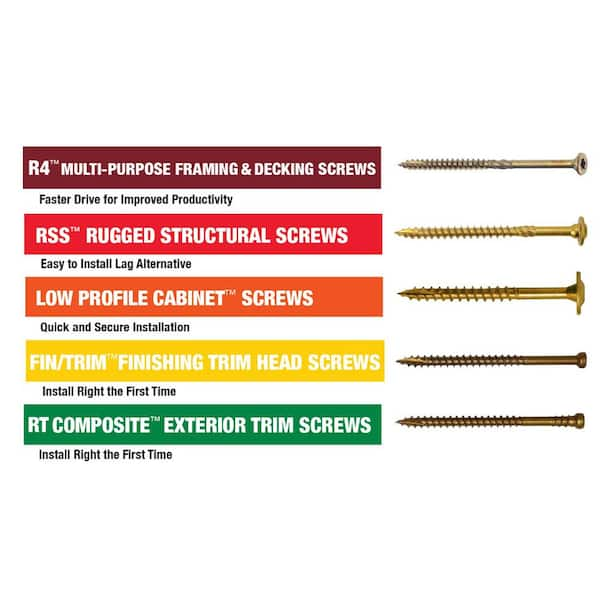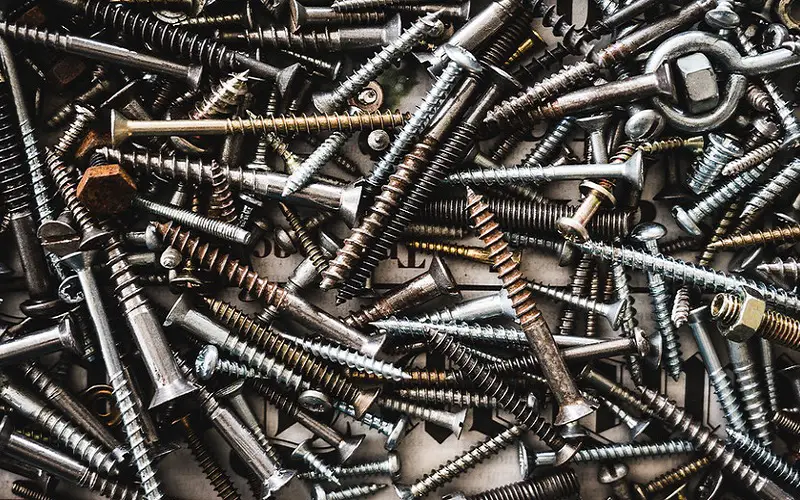The ideal size of screws for framing depends on the type and thickness of the framing material. Framing is a crucial step in construction that provides structural support for walls, floors, and roofs.
To ensure stability and strength, it is essential to use screws of the appropriate size. Selecting the right size of screws is determined by the material being framed wood, metal, or concrete and its thickness.
Additionally, the type of framing, such as wall studs, floor joists, or roof trusses, may influence the screw size needed.
This guide will discuss the recommended screw sizes for different framing materials to help you make informed choices for your construction projects. By using the correct size of screws, you can ensure the stability and longevity of your framing structures.

Contents
- Choosing The Right Screw Size For Framing
- Understanding Screw Measurements
- Factors To Consider When Choosing Screw Type
- Different Types Of Screws For Framing
- Common Mistakes To Avoid When Choosing Screw Size
- Tips For Proper Screw Installation In Framing
- Recommended Screw Sizes For Framing Applications
- Frequently Asked Questions On What Size Screws For Framing
- Conclusion
Choosing The Right Screw Size For Framing
Factors To Consider When Choosing Screw Size
- Material: Choose screws suitable for your framing material.
- Length: Ensure the screw length is appropriate for the thickness of the materials being joined.
- Diameter: Consider the diameter required for adequate strength and stability.
Commonly Used Screw Sizes For Framing
Below are some commonly used screw sizes for framing:
| Screw Size | Length (inches) |
|---|---|
| #8 | 2 to 3 |
| #10 | 3 to 4 |
| #12 | 4 to 6 |
Understanding Screw Measurements
Thread Size
The thread size of the screw is denoted by a number. It is important to ensure the screw thread size matches the material you are fastening to ensure a secure fit. For framing, a thread size of #8 or #10 is typically used. The higher the number, the thicker the screw.
Length
When it comes to framing, the length of the screw plays a critical role in ensuring structural integrity.
Typically, for framing applications, screws ranging from 2 to 3 inches in length are recommended.
It’s essential to select a length that provides enough grip without penetrating through the framing material.
Head Type
The head type is an important consideration when selecting screws for framing. For framing purposes, screws with a flat or bugle head are commonly used.
The flat head provides a flush finish, while the bugle head offers a more secure grip and reduces the risk of surface damage.
Factors To Consider When Choosing Screw Type
When choosing the right screws for framing, there are several factors to take into consideration in order to ensure the structural integrity and longevity of your project.
Understanding the factors that influence the choice of screw type is crucial for the success of any framing endeavor. Below, we will delve into the key factors to consider when deciding on the appropriate screw type:
Material Of The Framing
The material of the framing plays a pivotal role in determining the right screw type. For wood framing, coarse thread screws are typically recommended, whereas for metal framing, self-tapping screws are more suitable.
It’s essential to match the hardness and density of the framing material with the appropriate screw type to ensure a secure and durable connection.
Load Capacities
Considering the load capacities is crucial in determining the appropriate screw type for framing. High-strength screws are necessary for heavy load-bearing applications, while standard screws may suffice for lighter loads.
Understanding the anticipated loads that the framing will be subjected to is imperative in selecting screws that can effectively bear the intended weight without compromising structural stability.
Weather Resistance
When framing structures that will be exposed to the elements, such as outdoor decks or porches, weather resistance becomes a significant consideration.
Stainless steel screws are highly resistant to corrosion and are ideal for outdoor framing projects, whereas coated screws provide added protection against rust and moisture.
It’s essential to choose screws with adequate weather resistance to ensure the longevity of the framing in outdoor environments.
Different Types Of Screws For Framing
When framing, using the right size screws is crucial. Commonly, for heavy-duty framing, such as building decks or walls, use 3-inch wood screws. For lighter framing, like assembling furniture, 2-inch screws are suitable. It’s essential to choose the proper size based on the project’s requirements.
Different Types of Screws for Framing When it comes to framing projects, using the right type and size of screws is crucial for ensuring the stability and longevity of the structure.
Different types of screws are designed for specific materials and applications, each offering unique features that cater to the requirements of different framing projects.
Let’s explore the various types of screws commonly used for framing, including wood screws, drywall screws, deck screws, concrete screws, and metal screws
Wood Screws
Wood screws are specifically designed for fastening wood to wood. They have coarse threads and a sharp point, making them suitable for applications where a strong grip and secure attachment are needed.
Drywall Screws
Drywall screws, also known as gypsum board screws, feature fine threads and a bugle head. These screws are intended for attaching drywall to wood or metal studs, providing a durable and flush finish.
Deck Screws
Deck screws are specifically engineered for outdoor applications such as decking, fences, and outdoor furniture. These screws are resistant to corrosion and have self-drilling points, making them ideal for framing projects exposed to the elements.
Concrete Screws
Concrete screws, also called masonry screws or Tapcon screws, are designed for fastening materials to concrete, block, or brick. These screws feature a special thread design and often require pre-drilling before installation.
Metal Screws
Metal screws are suitable for attaching metal to metal or metal to wood. They are available in a variety of materials and coatings to resist corrosion and offer strong, reliable connections in metal framing projects.
In summary, understanding the different types of screws available for framing is essential for selecting the right fasteners to ensure the structural integrity and durability of your construction projects.
Each type of screw is engineered with specific features to accommodate various materials and project requirements, so choosing the appropriate screws is paramount for achieving successful framing results.
Common Mistakes To Avoid When Choosing Screw Size
Using Improper Length Screws
Using screws that are too short may not provide enough hold, risking the stability of the framing structure.
Not Considering Weight Loads
Screws that are too small may not bear heavy weight, leading to potential structural failure.
Ignoring Environmental Factors
Not taking into account factors like moisture or temperature can result in screws deteriorating over time.
Tips For Proper Screw Installation In Framing
Proper screw installation in framing requires selecting the right size screws to ensure structural stability. Use #10 or #12 screws measuring 3 to 3. 5 inches in length for framing applications.
Pre-drill pilot holes to prevent splitting wood and maintain a secure connection for long-lasting results.
Proper screw installation is essential when it comes to framing, ensuring stability and durability of the structure. From pre-drilling holes to using the right screw depth, there are a few key tips to keep in mind.
Pre-drilling Holes
Pre-drilling holes before driving screws is an important step in framing to prevent splitting or damaging the wood. It helps the screw to go smoothly into the wood without causing any cracks or weak spots.
To pre-drill holes, follow these steps:
- Choose a drill bit size slightly smaller than the diameter of the screw.
- Place the drill bit in your power drill.
- Hold the drill perpendicular to the wood surface and apply gentle pressure.
- Drill the hole to the desired depth, ensuring it is slightly deeper than the length of the screw.
Proper Screw Depth
Determining the proper screw depth is crucial to avoid over-tightening and damaging the wood or under-tightening and compromising the stability of the framing.
When choosing the screw depth, consider the thickness of the materials being joined. Ensure the screw goes deep enough to securely connect the pieces, but not too deep that it protrudes through the other side.
A good practice is to leave the screw head slightly recessed below the surface of the wood.
Using A Screw Gun
A screw gun is a power tool that can simplify and speed up the process of screw installation in framing.
Here are some tips for using a screw gun effectively:
- Choose a screw gun with the appropriate torque settings for the project.
- Hold the screw gun perpendicular to the wood and align the screw with the pre-drilled hole.
- Apply gentle and consistent pressure while driving the screw into the wood.
- Avoid over-tightening, as it can weaken the wood or strip the screw threads.
- Regularly check the screw depth to ensure it is consistent throughout the framing.
Recommended Screw Sizes For Framing Applications
When it comes to framing applications, selecting the correct screw size is crucial for the structural integrity of a project. From interior wall framing to roof truss installation, using the right size screws ensures durability and stability.
Interior Wall Framing
For interior wall framing, use 2 1/2-inch coarse-thread screws for wood studs and drywall applications. These screws provide strong grip and prevent over-tightening.
Exterior Deck Framing
Deck framing requires 3-inch stainless steel screws to withstand outdoor elements and moisture. These screws are corrosion-resistant and ideal for deck construction.
Roof Truss Installation
When installing roof trusses, opt for 3 1/2-inch galvanized screws to secure trusses firmly in place. These screws offer superior strength and weather resistance.


Frequently Asked Questions On What Size Screws For Framing
What Size Screw For 2×4 Framing?
For 2×4 framing, use 3-inch screws for securing the boards. This provides strong and stable construction.
What Size Screws For Stud Framing?
Use 2 1/2-inch screws for framing with 2×4 studs. For 2×6 studs, use 3 1/2-inch screws. Shorter screws may not hold securely, while longer screws can damage the studs.
It’s essential to choose the right length for the specific stud size to ensure stability and durability in the framing.
What Size Screw Is Best For Stud?
The best size screw for a stud is typically #8 or #10, measuring 2 to 3 inches in length. These screws provide a secure fit for most stud applications.
What Size Screws For 2×6 Framing?
For 2×6 framing, use 3-inch screws to secure the boards effectively. These screws provide adequate grip and support.
Conclusion
Choosing the right size screws for framing is crucial for structural stability. Whether you opt for #8 or #10 screws, ensure they are of high quality.
Follow manufacturer guidelines and remember, proper fastening is key to a successful framing project.

